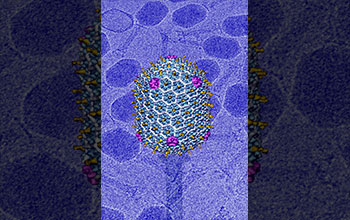Multimedia Gallery
Capsid of bacteriophage T4 virus
This figure shows the capsid, or outer shell, of a virus called bacteriophage T4. Proteins called gp23 are represented in blue and gp24 are represented in magenta. Both of these proteins are critical for the assembly of the T4 capsid.
More about this Image
Researchers have found the T4 virus and another virus called HK97 both have similar protein folds in their outer shells. These findings are providing further evidence that the protein envelope protecting DNA in viruses evolved billions of years ago from a common ancestor and uses the same basic protein fold to construct the outer shell. Researchers used X-ray crystallography to view the gp24 protein at a resolution of 2.9 angstroms and electron microscopy to view the virus capsid at 22-angstrom resolution. An angstrom is one ten-billionth of a meter, or roughly 1 millionth as wide as a human hair.
This National Science Foundation-funded research is aimed at understanding the structures of viruses. (Date of Image: May 18, 2005)
Credit: Image courtesy Purdue University Department of Biological Sciences
Images and other media in the National Science Foundation Multimedia Gallery are available for use in print and electronic material by NSF employees, members of the media, university staff, teachers and the general public. All media in the gallery are intended for personal, educational and nonprofit/non-commercial use only.
Images credited to the National Science Foundation, a federal agency, are in the public domain. The images were created by employees of the United States Government as part of their official duties or prepared by contractors as "works for hire" for NSF. You may freely use NSF-credited images and, at your discretion, credit NSF with a "Courtesy: National Science Foundation" notation.
Additional information about general usage can be found in Conditions.
Also Available:
Download the high-resolution JPG version of the image. (1.5 MB)
Use your mouse to right-click (Mac users may need to Ctrl-click) the link above and choose the option that will save the file or target to your computer.



 All images in this series
All images in this series